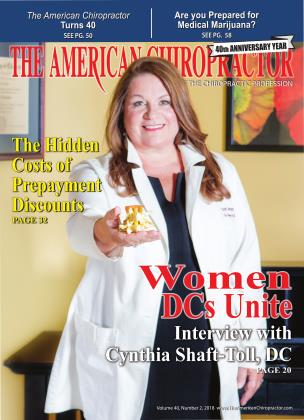Combining Therapeutic Laser and Whole-body Vibration in Patient Care
THERAPY
Dana Underkofler-Mercer
MS, DC
Laser Therapy
Light amplification stimulated by emission of radiation therapy, commonly known as laser therapy, is fast becoming the passive modality of choice by many practitioners for pain treatment and quicker healing times of musculoskeletal injuries. In fact, both patients and doctors are seeing results immediately or within just a few treatments.
It is important to understand the foundation of how therapeutic laser works and the physics behind the process to help educate both the patients who will receive this beneficial therapy and the doctors who will use and implement the equipment.
Laser therapy, a form of nonionizing radiation, consists of photons of light that reach a certain target area by proper wavelengths (mn) fueled by watts (mW). The watts then generate energy (joules) on a cellular level (activation of cytochrome c-oxidase) to promote healing (photobiomodulation).
Simply put, the photons of light reach the target tissue and generate the energy needed for healing and pain relief.
A common misconception is that LEDs (light emitting diodes) are lasers, but LED light is noncoherent or divergent. Laser light is coherent or nondivergent and monochromatic, meaning it has only one color or wavelength confined to a narrow spectrum. Laser light also has the capability to reach deeper target tissue, whereas LED light is mostly superficial.
Cellular Targets in Red and Near Infrared (NIR) Wavelengths
“ A common misconception is that LEDs (light emitting diodes) are lasers, but LED light is noncoherent or divergent. 5 5
Below is a chart that explains wavelength in more detail.
Three Classifications of Laser Therapy A Class Ilia therapeutic laser is powered by a low wavelength (less than 5 mW) and generates minimal amounts of energy within the tissues, which is why it is generally used in acupuncture and for superficial injuries.
Class Illb lasers are powered from 5 to 500 mW and generate more energy, enabling the laser to reach deeper target tissue to promote vasodilation and healing through photobiomodulation.
A Class IV laser is any therapeutic laser over 500 mW. They may be a pulsed or continuous wave and may consist of single or multiple wavelengths within the unit to reach multiple target areas for treatment. Class IV therapeutic lasers are the most widely used laser at Logan University, as well as by many professional and collegiate sports facilities throughout the country, due to faster treatment and healing times.
Whole-body Vibration
Therapeutic lasers are being used to treat a myriad of joint and musculoskeletal injuries. Both doctors and patients are seeing pain relief, reduction of edema, increased circulation and ranges of motion, and faster wound healing times.
In combination with the treatment of therapeutic lasers on musculoskeletal injuries and joint pain, there have been remarkable benefits of incorporating whole-body vibration (WBV) therapy during the active-care phase.
Russian scientist Vladimir Nazarov first used WBV to treat the loss of bone density and muscle mass in cosmonauts. The benefits of WBV quickly spread, and machines are now being used globally in clinics, rehabilitation centers, and collegiate and professional sports arenas.
Using WBV after the use of laser therapy has shown to substantially catapult patient treatment outcomes when incorporated after the acute phase of injury has
subsided and the patient is ready for active rehabilitation.
The vibration frequency (15 Hz to 60 Hz) with desired amplitude (2 mm to 10 mm) stimulates subconscious contraction and relaxation of both agonist and antagonist muscle groups ranging anywhere from 20 to 50-plus times per second. This ensures that all “hands” (muscles) are on deck and active.
This type of therapy works well for a patient with weak biceps, gluteus muscles, or core strength because he or she would traditionally voluntarily try to compensate by using other muscles including erectors and back or leg muscles. However, with proper WBV parameters, more muscle motor units are recruited in the target area.
Additionally, WBV allows for reduced joint loading while encouraging proper muscle firing sequence and increased strength and stability. This is important when treating common injuries, such as plantar fasciitis, joint restriction, and adhesive capsulitis. Increased range of motion, circulation, and proprioception is usually achieved both visually and functionally within one treatment.
New research on the benefits of WBV is continually discussed and developed. Some research studies have shown to increase muscle mass, strength, and tone, with the higher amplitude levels being the most important factor. Other research has shown increased bone density, circulation, lymph drainage, cellulite reduction, decreased cortisol levels, enhanced explosive power in athletes, increased coordination and proprioception, which also is key in treating patients with multiple sclerosis, Parkinson’s disease, stroke, and osteoarthritis.
Doctors and their patients will see remarkable results and long-term outcomes by first treating with therapeutic laser for joint pain reduction, tissue healing, degeneration, acute or chronic injuries and disease, and then immediately incorporating WBV during active care for increased range of motion, improved muscle firing sequence, strength, joint stability, balance, proprioception, coordination, and circulation. The benefits, research, and treatment options continue to grow in popularity and are becoming a standard in patient care.
Dr Dana Underkofler-Mercer is an Associate Professor at Logan University and earned a Bachelor of Science in Human Biology, Doctor of Chiropractic Degree (1998) and a Master of Science in Sports Science and Rehabilitation (2010) from Logan University. She is a certified Medical Laser Safety Officer and has lectured on laser safety and applications in the classroom, post graduate seminars, and at AFIDE in Havana, Cuba. Dr Mercer has been in private practice in the St. Louis area and has worked at Logan University as a Clinician in the Student and Outpatient Health Centers. She has been instrumental in the development of Logan ⅛ health center at Paraquad, and in creating the Anatomy Centered Education and Science (A.C.E.S) summer workshop program for high school students interested in careers in various health fields.
 View Full Issue
View Full Issue






